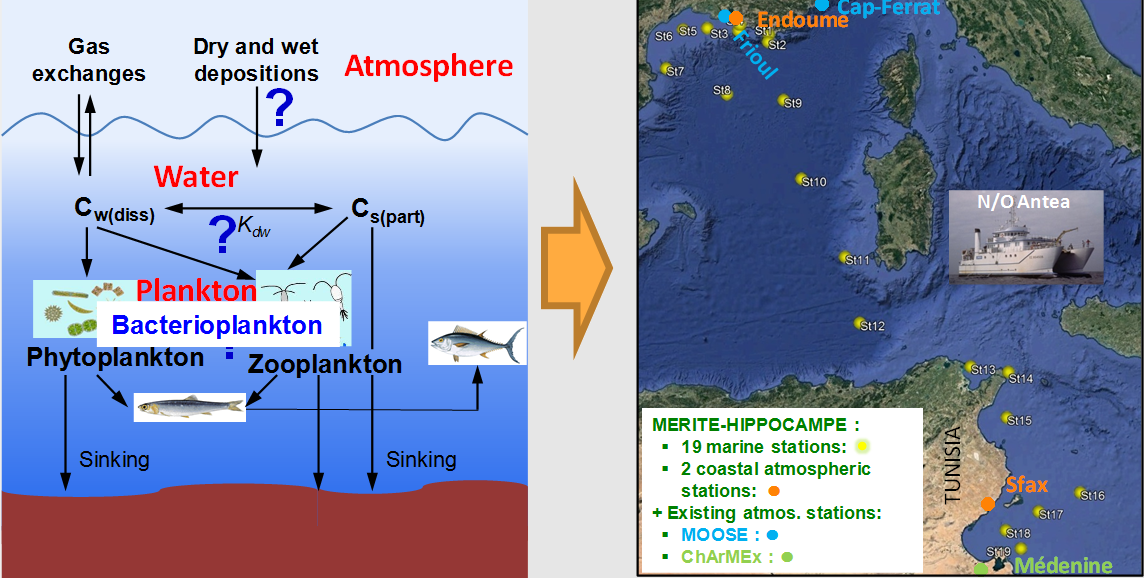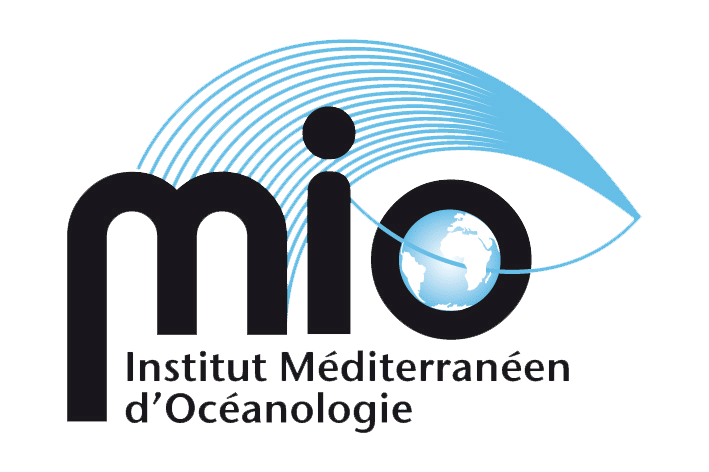PI MERITE HIPPOCAMPE programme (AT Pollution & Contaminants, MISTRALS) : Marc Tedetti, F. Carlotti, Mr Pagano (MIO), J. Tronczynski (IFREMER), S. Sammari (INSTM, Tunisia)
Head of Mission: Marc Tedetti,
A team of 16 French and Tunisian scientists led by researchers from the MIO (UMR CNRS, IRD, AMU, UTLN) and IFREMER is carrying out a 30-day trans-Mediterranean campaign (13 April-14 May 2019), dubbed MERITE-HIPPOCAMPE, to characterise the state of health of marine ecosystems, in particular plankton contamination in areas of ecological interest in the north and south of the Mediterranean.
The IRD in Tunisia!
The MERITE-HIPPOCAMPE trans-Mediterranean campaign is taking place on board the ANTEA, an ocean-going vessel belonging to the French Oceanographic Fleet of the 13 April to 14 May 2019 between La Seyne-sur-Mer and the Gulf of Gabès (mission leader M. Tedetti). 19 stations spread over 1,500 km were selected for sampling along a north-south gradient, from highly anthropised coastal areas to the open ocean. The main aim of MERITE-HIPPOCAMPE is to increase our knowledge of the accumulation and transfer of metallic and organic elements resulting from human activities within planktonic organisms - from bacteria to zooplankton - under the effect of atmospheric and continental forcing.
Aboard the ANTEA, the teams are collecting samples of seawater, plankton and atmospheric deposits over an area of more than 1,500 km between La Seyne-sur-Mer and Gabès. Extensive analytical equipment and sampling facilities are deployed to measure a wide variety of biological, physical and chemical parameters in the water, as well as in planktonic organisms. It was a real technical challenge for the teams to carry out this work on board the ship, and then in the French and Tunisian laboratories.
Flagship project of the Transverse Pollution and Contaminants Axis of the programme MISTRALS (CNRS/INSU)the MERITE-HIPPOCAMPE campaign is an international, trans-Mediterranean, multi-research institute and transdisciplinary project which will identify :
- The role of marine plankton as a "biological pump" for contaminants
- The role of atmospheric deposition in the contamination of marine ecosystems
- The role of different plankton size classes in the accumulation of contaminants
- The role of trophic interactions in the accumulation/transfer of contaminants
- The link between habitat characteristics and plankton contamination in different ecoregions
The information gathered will be used to characterise the state of health of marine ecosystems, in particular the contamination of plankton in areas of ecological and economic interest in the north and south of the Mediterranean.
This research campaign is funded by the MISTRALS by CNRS/INSU, Ifremer, IRD. It is mainly used by French laboratories MIO (IRD / CNRS / AMU / UTLN) and BE, LBCM and LERPAC (IFREMER), and Tunisian laboratories INSTM and FSB (Tunisia's Ministry of Agriculture, Hydraulic Resources and Fisheries, and Ministry of Higher Education and Scientific Research). This Franco-Tunisian cooperation is part of the LMI Cosys-Med (IRD), which organises and supports joint research initiatives. It also involves partnerships with LRTA (IRSN) and LISA (CNRS/Universities of Paris-Est Créteil, Paris Diderot) and theIMT-Lille-Douai.
The MOI, as initiator and organiser of the campaign, is involving researchers from these 5 research teams.
Cédric Garnier, François Carlotti, Marc Tedetti and Marc Pagano from the MIO and Jacek Tronzynski (Ifremer) are the initiators of this project, which began with parallel operations in the Gulf of Lion and the Gulf of Gabes (MISTRALS / MERMEX-MERITE Programme 2016-2018) before the launch of this trans-Mediterranean campaign (MISTRALS Programme / Transverse Pollution and Contaminants Axis). Oceanographers, chemists, microbiologists and planktonologists from the MIO (~20 researchers and engineers from IRD, CNRS, AMU and UTLN) are part of the scientific team.
In this programme, the MIO is at the heart of a triple cooperation:
MIO - IFREMER cooperation (teams BE, LBCM and LERPAC) in the field of chemical, organic and metallic contamination, and microplastics. Chemists and biologists from both organisations have developed innovative techniques for collecting and measuring contaminants in very fine fractions of particles and plankton.
For several years now, Franco-Tunisian cooperation has been organised as part of the COSYS-Med international joint laboratory (IRD) is largely highlighted in this campaign through joint observations by researchers from the MIO and Tunisian laboratories INSTM and FSB on hydrodynamics, plankton, particulate and dissolved matter in the sea, and associated contamination. This trans-Mediterranean study from the Gulf of Lion to the Gulf of Gabes is a first and will benefit from the knowledge of the different teams. This oceanographic campaign will complement the work carried out in recent years on the southern and northern shores to provide a better understanding of the functioning of the Mediterranean marine environment. Finally, training is also an important aspect, with three Tunisian doctoral students and one post-doctoral student taking part on board ANTEA.
Mermex-Charmex cooperation. Atmospheric inputs of contaminants into the ocean will be measured on land (collection of atmospheric deposits from March 2019 to June 2020 in the north (Marseille) and south (Sfax) of the Mediterranean) and, during the Hippocampe campaign, on board the ANTEA. The expertise of the LISA and LSCE laboratories, developed during several operations in the Charmex programme, will once again be put to use in this campaign.
As well as contributing to scientific knowledge, the project also aims to raise public awareness of global changes in the Mediterranean Sea.
The vulnerability of the Mediterranean environment to global change no longer needs to be demonstrated. To raise public awareness of the fragility of this ecosystem, scientists welcomed high school students on board the ANTEA vessel during its stopover in Tunis at the end of April, according to a programme drawn up by the IRD in Tunisia. In addition, the general public can follow the progress of the campaign via a online logbook and powered by the crew.

MIO M. Tedetti, F. Carlotti, M. Pagano, M. Quéméneur, L. Guilloux, D. Malengros, C. Chevalier, V. Rossi, S. Chifflet, L.-E. Heimbürger-Boavida, C. Guigue, S. Jacquet, A. Dufour, R. Sempéré, B. Misson, L. Cabrol, P. Cuny, O. Pringault, M. Thyssen, G. Grégori, D. Banaru.
IFREMER J. Tronczynski, J. Knoery, N. Briant, B. Thomas, C. Ravel , C. Brach-Papa, F. Galgani,
CEREGE T. de Garidel,
LSCE F. Dulac,
LISA : K. Desboeufs,
FSB A. Sakka Hlaili, N. Daly, N. Makhlouf (thesis), M. Meddeb (post-doc),
IMT Douai A. Bourin,
INSTM S. Ben Ismail, C. Sammari, M. Brahim, L. Chouba, M. Belhassen, N. Zaaboub, A. Zouari, I. Boudriga (thesis), M. Mahfoudi,
IRSN O. Radakovitch,
SEDOO P. Vert, H. Ferré.
Questions addressed in MERITE-HIPPOCAMPE
- The role of atmospheric deposition in contaminating marine waters?
- The role of different plankton size classes in the accumulation/transfer of contaminants?
- The role of trophic interactions in the accumulation/transfer of contaminants?
- The link between habitat characteristics and plankton contamination?

Coupled atmosphere-ocean studies
| HIPPOCAMPE trans-Mediterranean sea campaign (N/O Antéa, 13 April-14 May 2019) -> 19 stations | Monitoring atmospheric deposits in the north (Marseille) and South (Sfax) of the Mediterranean (Jan. 2019-June 2020) |





